Introduction and Outline
- Quality improvement project: catheter-associated urinary tract infections (CAUTIs) control.
- Outline:
- Problem statement, significance, and PICOT.
- Literature review.
- Methodology (framework, design, procedures).
- Findings, implications, recommendations, conclusions.
This presentation will review a quality improvement project. Its focus was on catheter-associated urinary tract infections (CAUTIs), and it was aimed at improving the ability of a particular long-term care unit to control them. This presentation will cover the project’s problem statement, explain its significance, and present the PICOT question, as well as the stated purpose. A very brief literature review will be provided as well, and the methodology will be discussed in great detail. Finally, the findings will be summarized and then discussed to include a reflection on implications, recommendations, and contributions of the project.
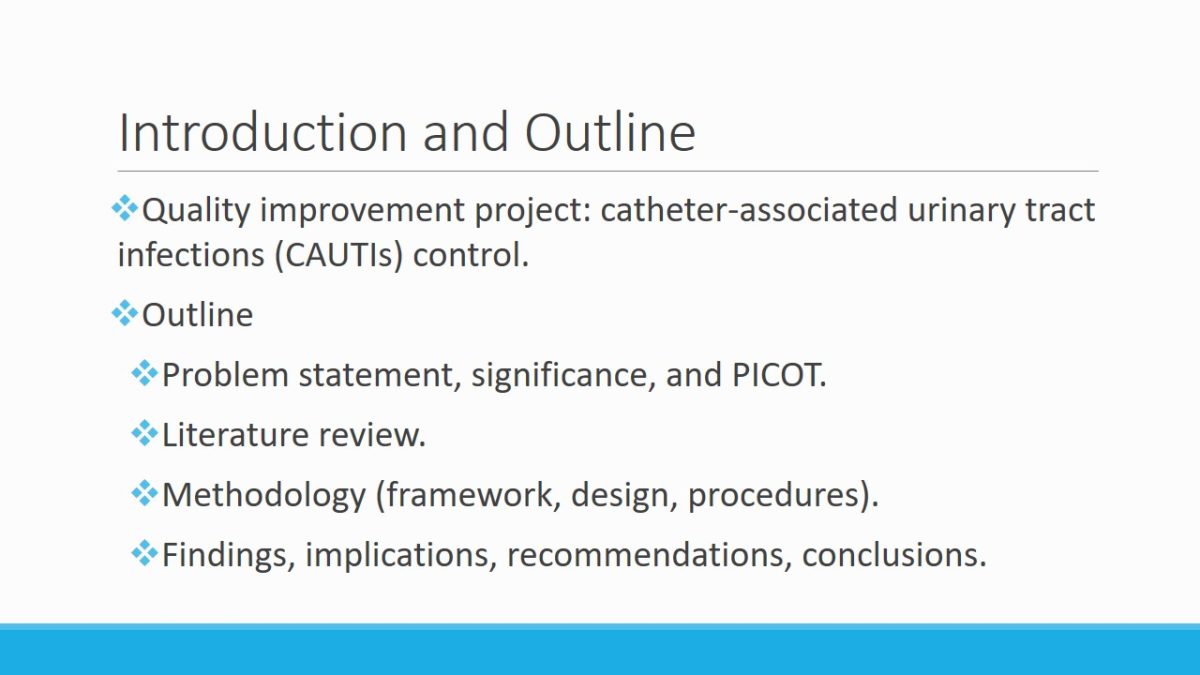
Problem Statement and Significance
- CAUTIs as a problem:
- 12.9% of hospital-acquired infections are UTIs;
- 67.7% of UTIs are CAUTIs (Nicolle, 2014);
- common in older adults (Jump et al., 2018);
- have negative outcomes (including disability and death).
- The role of nurses: prevention and management to ensure the quality of care/patient safety.
In order to explain the significance of the problem of CAUTI, it is necessary to mention that this issue is very prevalent. Indeed, urinary tract infections (UTIs) constitute almost 13% of all infections that are acquired by patients in hospitals, and almost 68% of those are associated with catheters (Nicolle, 2014). Moreover, CAUTIs are especially common among particular populations and settings, which includes the older residents of long-term facilities (Jump et al., 2018). Finally, these infections are also dangerous; they can result in multiple negative outcomes, including lethal ones. As a hospital-acquired condition, CAUTIs are especially important to prevent and manage appropriately, and nurses play a crucial part in this endeavor. Thus, the introduction of a quality improvement project that would target such a problem is fully justified by its significance.
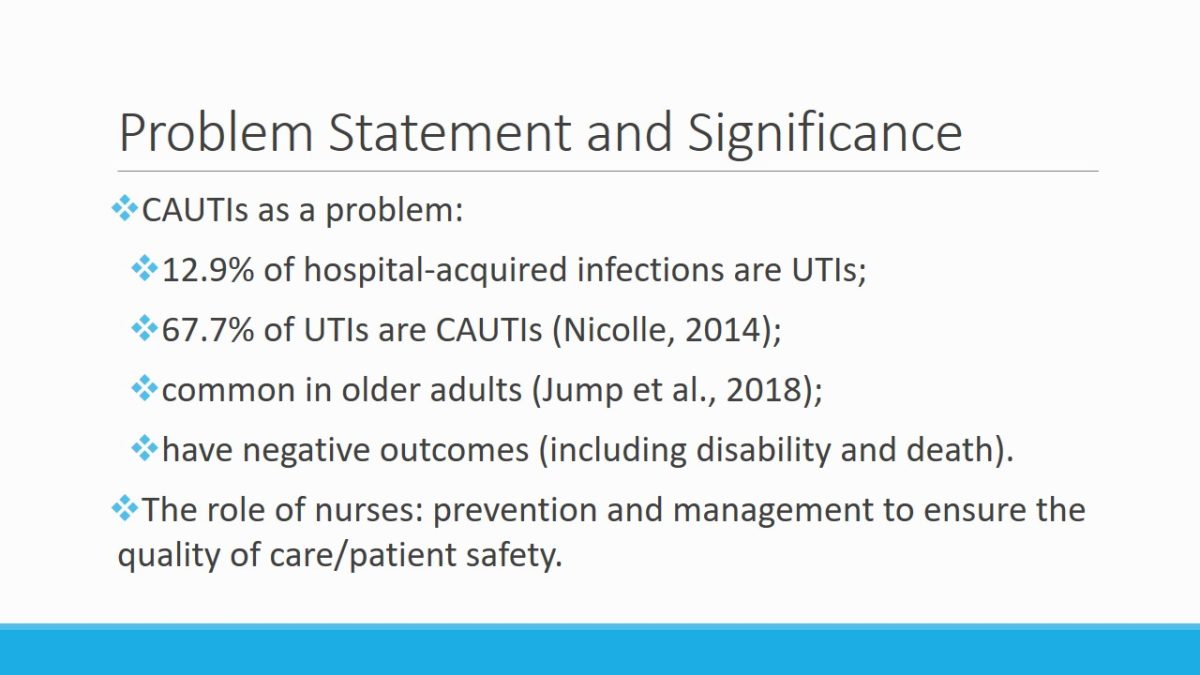
Literature Review
- Chlorhexidine: an antiseptic, common for decolonization strategies (Noto & Wheeler, 2015).
- Bathing with 2% chlorhexidine gluconate washcloths can prevent CAUTIs (Huang, Chen, Wang, & He, 2016; Mitchell et al., 2019; Swan et al., 2016).
- Nurse knowledge of CAUTI may be insufficient (Jain, Thakur, Dogra, Mishra, & Loomba, 2015).
A review of the literature related to CAUTI prevention can help to gain insights into the project and its intervention. The fact that chlorhexidine has antiseptic properties has been employed in nursing to reduce colonization, which is connected to CAUTIs (Noto & Wheeler, 2015). There exist different specific approaches (Mitchell et al., 2019), but chlorhexidine bathing, specifically with the help of 2% chlorhexidine gluconate washcloths, is a method that is evidenced to be effective when compared to non-chlorhexidine bathing. This conclusion is based on randomized trials and their meta-analyses (Huang et al., 2016; Swan et al., 2016). In addition, this project encountered some evidence which showed that nurses might experience difficulties with CAUTI prevention and lack the knowledge related to it. This problem was demonstrated in a study by Jain et al. (2015) with a sample of over 100 nurses. To summarize, the literature supported the idea that the chosen problem was significant, supplied an evidence-based solution, and provided evidence on the challenges that the presented project might encounter.

PICOT and Purpose
Purpose: preventing/reducing CAUTIs in long-term care.
PICOT: For senior residents ages 65 years and above of long-term care facilities (P), how does the use of a disposable washcloth with 2% chlorhexidine gluconate (I) compared to standard catheter care (C) affect the rate and prevalence of catheter-associated urinary tract infections (O) within a two-week period (T)?
This slide demonstrates the PICOT question, as well as the purpose of the project. Its goal was mostly to prevent or reduce CAUTI incidence in a long-term care facility; in particular, residents older than 65 were the population. The evidence-based intervention was the washcloths, and the comparison was care-as-usual, that is, bathing without the washcloths. The measured outcome was concerned with CAUTIs, and the timeframe was limited to two weeks.

Framework
- Unfreezing: training (explaining the value of the intervention).
- Change: the project (applying and testing the intervention).
- Refreezing: post-project stage; the project prepares for it.
- Has been used in nursing; simple but provides the necessary structure (Cummings, Bridgman, & Brown, 2016).
The project utilized a framework that would enable the integration of the new bathing method into the site’s routine. Specifically, Lewin’s (1947) model was chosen because it is a very common framework that provides the necessary structure while being simple to use. The fact that it has been employed in healthcare means that it is applicable to the described project (Cummings et al., 2016). The model incorporates three stages; first, it is necessary to enable change by unfreezing the existing status quo. To ensure the completion of this stage, the described project incorporated training aimed at advancing the understanding and knowledge of CAUTIs, the intervention, and its correct application in the nursing staff of the site. Following this stage, the change itself took place, which mostly consisted of the rest of the project. Due to its short timeframe, the refreezing stage would mostly occur after the project depending on the findings; however, the two prior stages prepared the ground for it. This way, the framework was employed to enable the compliance of the nursing staff and the correct application of and adherence to the intervention.
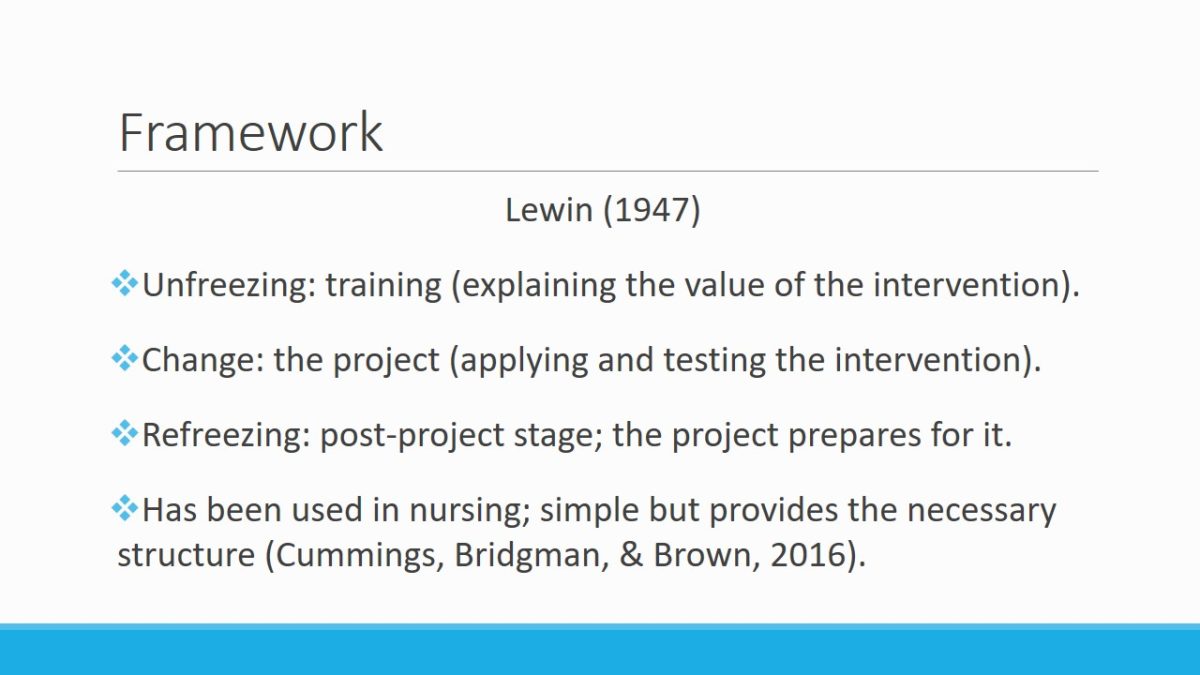
Design
- Methodology: pre-test post-test.
- Intervention: routine bathing with a disposable washcloth (2% chlorhexidine gluconate) for 2 weeks.
- Site: 100-bed unit; a long-term care facility (high CAUTI rates).
- Final sample: 26 nurses/nursing assistants; 4 residents (65-90 years old, indwelling/suprapubic Foley catheter).
The design of the project can be characterized as a pre-test post-test study, in which routine bathing with disposable 2% chlorhexidine gluconate washcloths was tested against care-as-usual for two weeks. The site was a 100-bed unit of a long-term care facility, which has been exhibiting rather high CAUTI rates; from this perspective, the purpose of the project was directly associated with quality improvement. The final sample of the project consisted of 26 nurses and nursing assistants who were a part of the training activity; they were then engaged in caring for the residents, including the four residents who were involved in the project and its bathing procedures for 2 weeks. The primary eligibility criterion for the nurses was the fact of their work in the unit; for the residents, the criteria included their age and the presence of an indwelling or suprapubic Foley catheter, which put them at risk of CAUTIs.
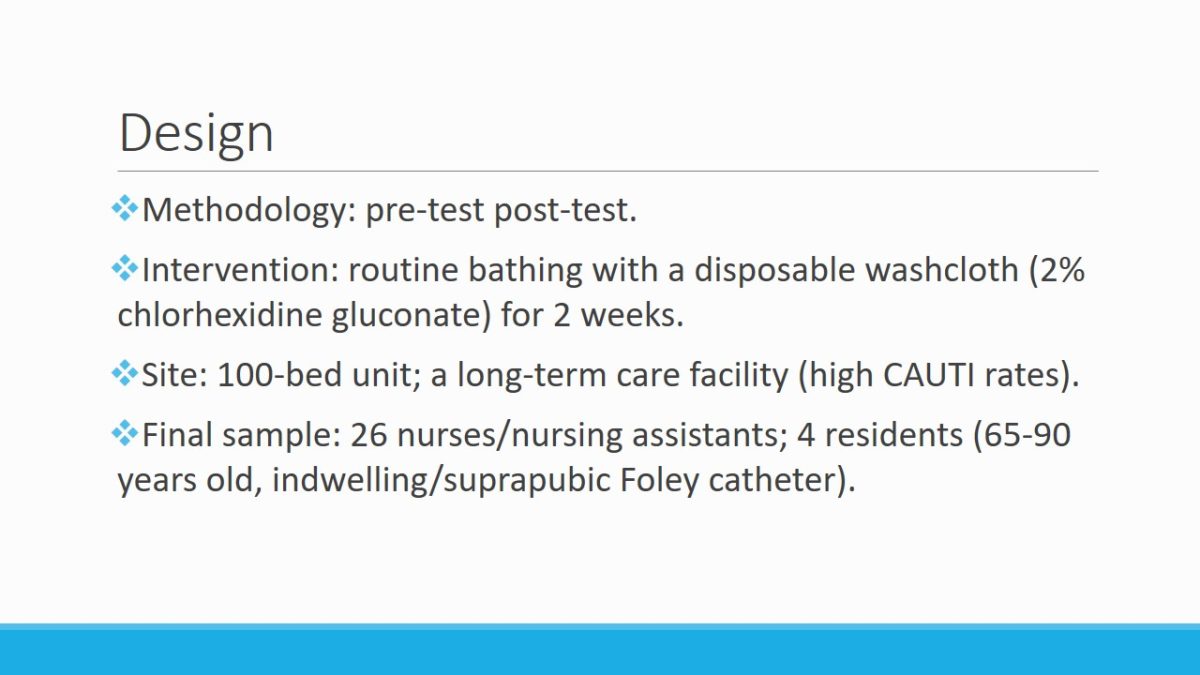
Procedures and Ethics
- Staff:
- Recruitment; minimal risks.
- Pre-training assessment.
- Training (30-minutes session with handouts and hands-on demonstration).
- Post-training assessment.
- Residents:
- Recruitment (informed resident/guardian consent).
- Pre-test data collection.
- Bathing with the washcloths.
- Post-test data collection.
The ethical considerations were taken into account while planning the project; it was fully approved by the university’s review board. The risks associated with participation were minimal, especially for the staff, but everybody involved was provided with all the necessary information, and all the recruited people signed informed consent forms. It should also be noted that for the participants who needed guardian consent, that consent was also granted.
The project proceeded with the following actions. With the staff, the intervention consisted of training, which took 30 minutes and involved a theoretical section and a demonstration. Before and after that event, their CAUTI knowledge was assessed, after which the nurses proceeded with their usual duties and the implementation of the intervention. Regarding the residents, their pre-test urine samples, as well as the information about CAUTI symptoms, were collected and checked. After the assertion of their eligibility, they were bathed with the washcloths for the following two weeks, after which their samples were collected once again.
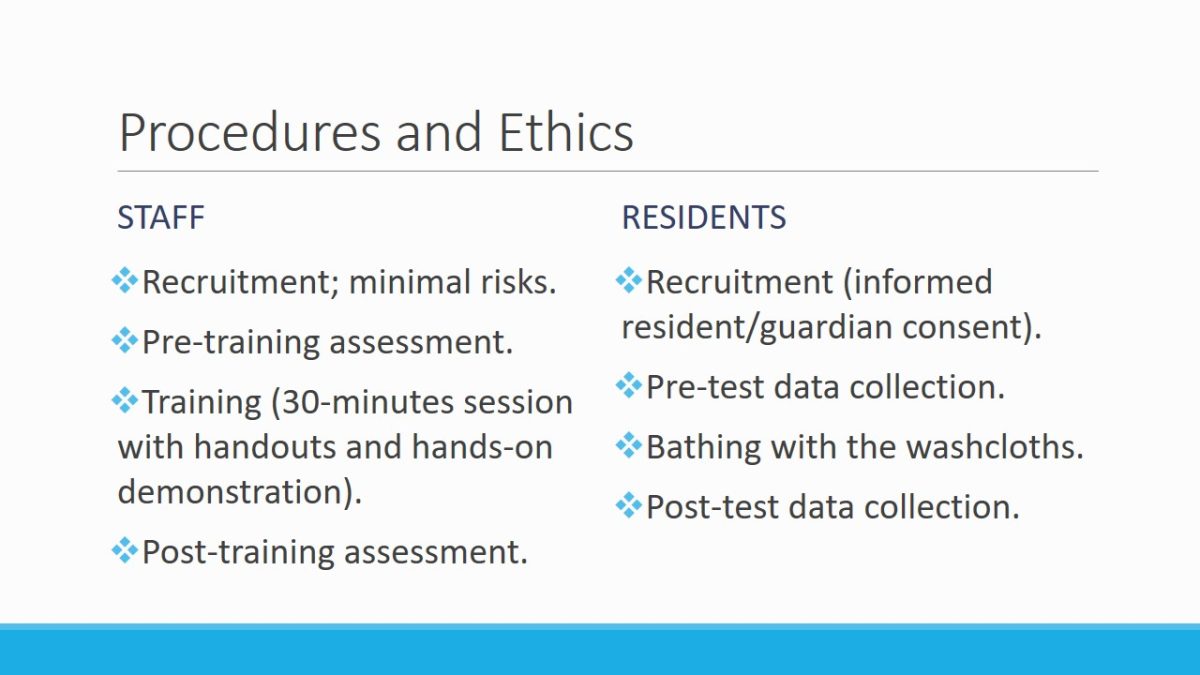
Data Collection and Analysis
- Staff:
- Tool: a survey based on Jain et al. (2015).
- Analysis: Wilcoxon signed ranks test (non-normal distribution) (Polit & Beck, 2017).
- Residents:
- Tool: dipstick urinalysis (leukocytes and nitrite).
- Analysis: descriptive statistics.
The data collection, which took place before and after interventions, was carried out with the help of special tools. Thus, the staff’s CAUTI knowledge was measured with a survey, which was based on the study of CAUTI knowledge by Jain et al. (2015). The tool also incorporated some questions about the demographics of the sample. For residents, the dipstick urinalysis was used, and leukocytes and nitrite in their urine were employed as the measures of their health.
Regarding the analysis, the features of the final datasets allowed determining the suitable approach. Thus, the distribution of CAUTI knowledge scores was not normal, which ruled out the application of the t-test to the staff’s data (Polit & Beck, 2017). However, the Wilcoxon signed ranks test remained applicable, which is why it was employed. Also, descriptive analysis was applied to demographics. With residents, the small sample and lack of changes prevented the application of statistical tests, but the data were summarized, and descriptive statistics were helpful in completing this task.
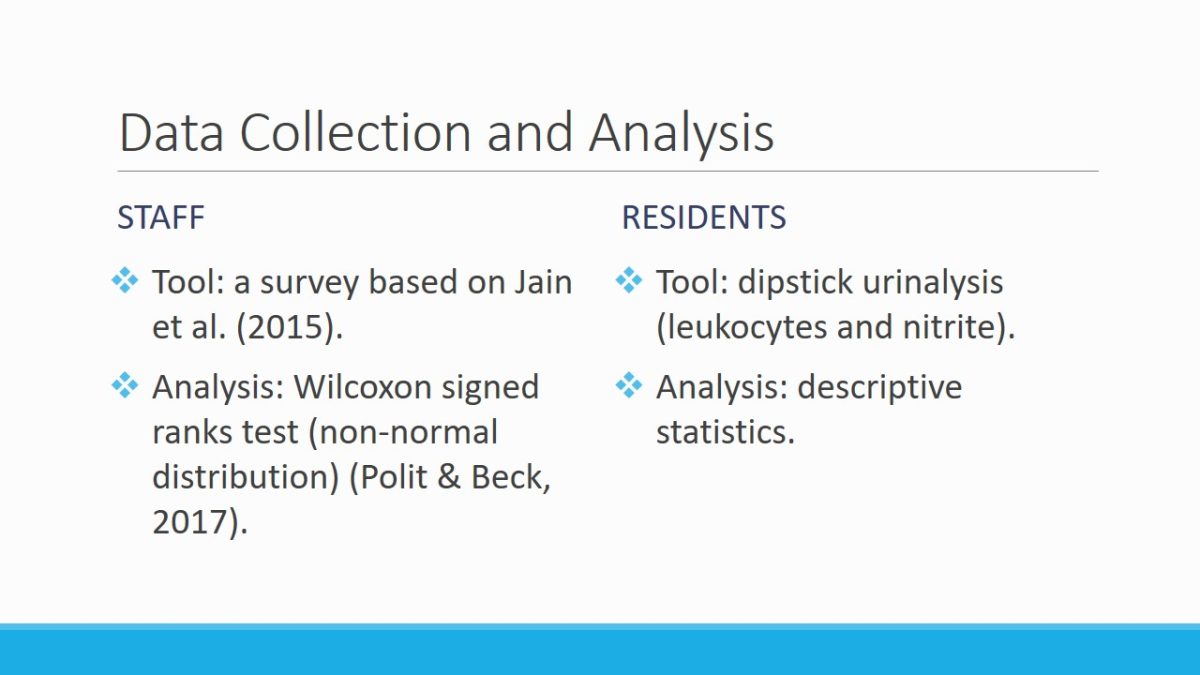
Findings: Demographics (Staff)
Upon analyzing the data, the following findings can be reported. The staff’s questionnaire included questions about their demographics, and it turned out that the nurses and nursing assistants who had been enrolled were all women. You can see the detailed information describing the sample’s experience and age in these two charts. Almost two-thirds of them (66%) had more than five years of experience in nursing, and 74% were older than 30 but younger than 60.

Findings: Nurse Survey Results
The results of their CAUTI knowledge survey are displayed here. These graphs show the prevalence of scores earned by the participants; higher scores indicate better knowledge. Before training, no participant earned a score that would be higher than 13; after the training, one participant earned 14 points, and one had the maximum number of points, which was 16. Therefore, some changes in the score prevalence took place after the training.
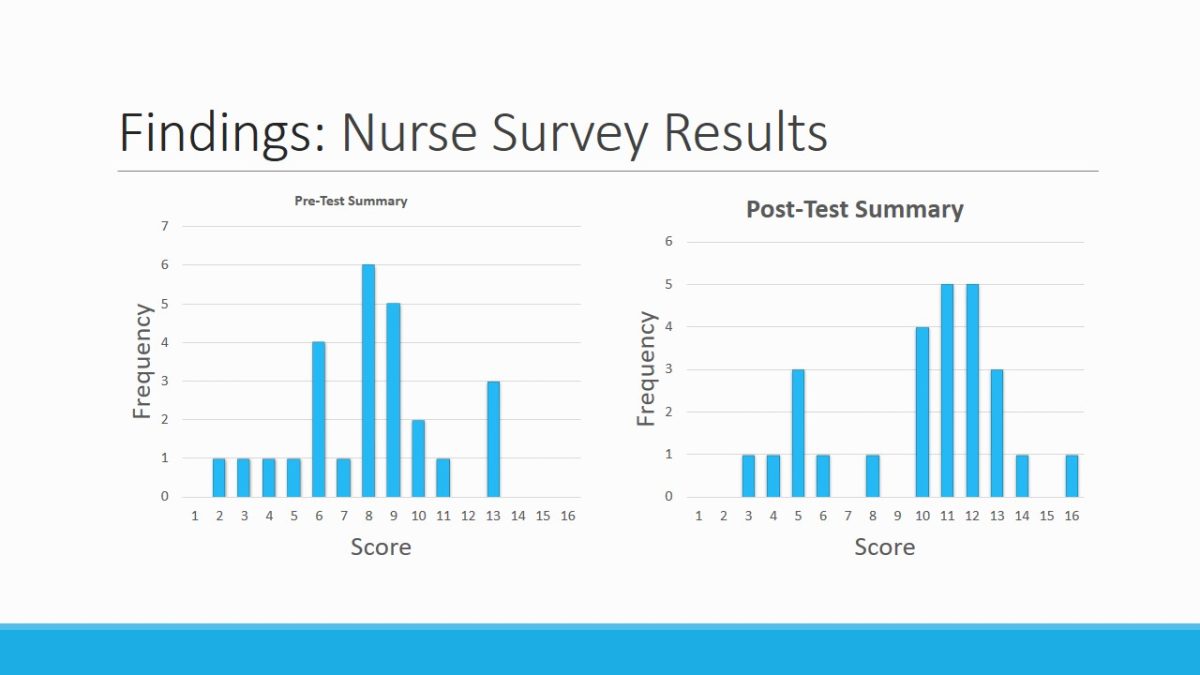
Indeed, the average pre-test score was 8, but the post-test one was 10. The Wilcoxon signed ranks test allows concluding that this increase was statistically significant; with p=0.004, the differences in the scores before and after the training cannot be explained as accidental fluctuations. Most likely, they are attributable to the independent variable, which was training.
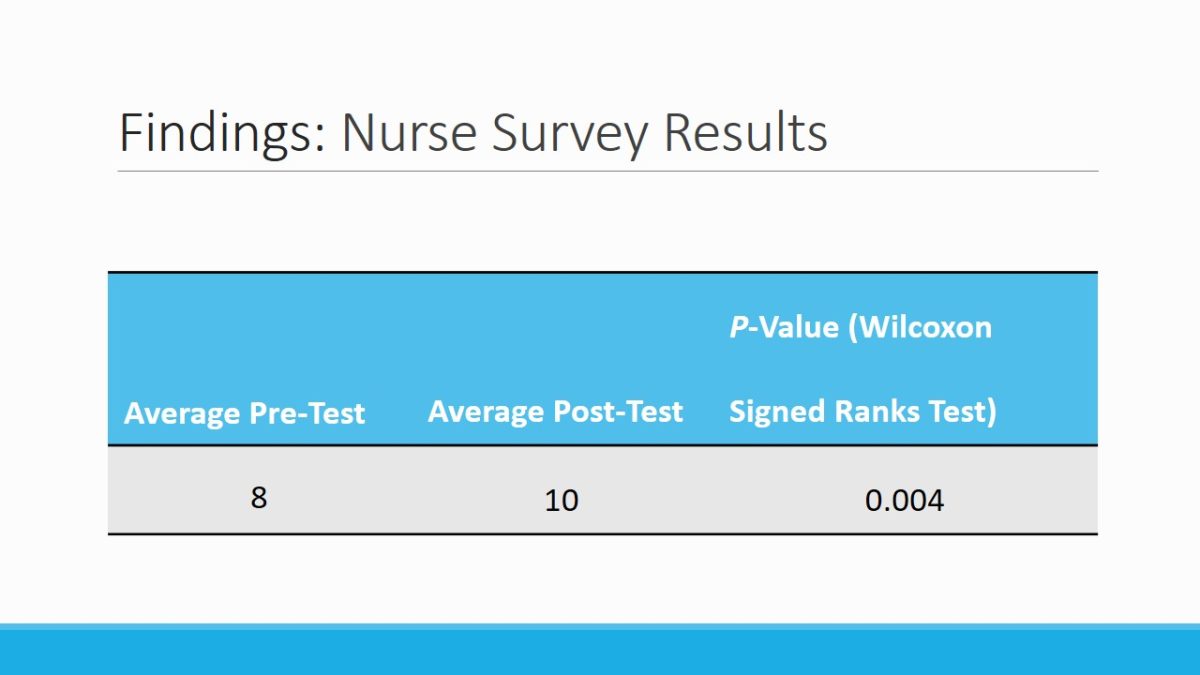
Discussion and Interpretation
- Relatively experienced staff.
- P<0.05; the training was effective (with this sample).
- The staff was well-equipped to perform the intervention.
- Staff with gaps in CAUTI prevention knowledge pre-training:
- Consistent with Jain et al. (2015): CAUTI knowledge may be lacking.
The staff data allows making the following statements. First, the majority of the staff that was engaged in the project was fairly experienced, which increases the likelihood of them being able to apply the intervention correctly. Second, due to the difference between the scores being statistically significant, the training is likely to be responsible for the increase, which implies that it has successfully improved the participants’ CAUTI knowledge. In other words, the training was proven to be effective. In turn, that means that the participants should have applied the intervention knowingly. However, the fact that some of the participants scored rather poorly implies that the literature review findings are supported by this project (Jain et al., 2015); nurses can indeed lack crucial information about CAUTIs, which highlights the importance of training them before tasking them with the bathing procedures.
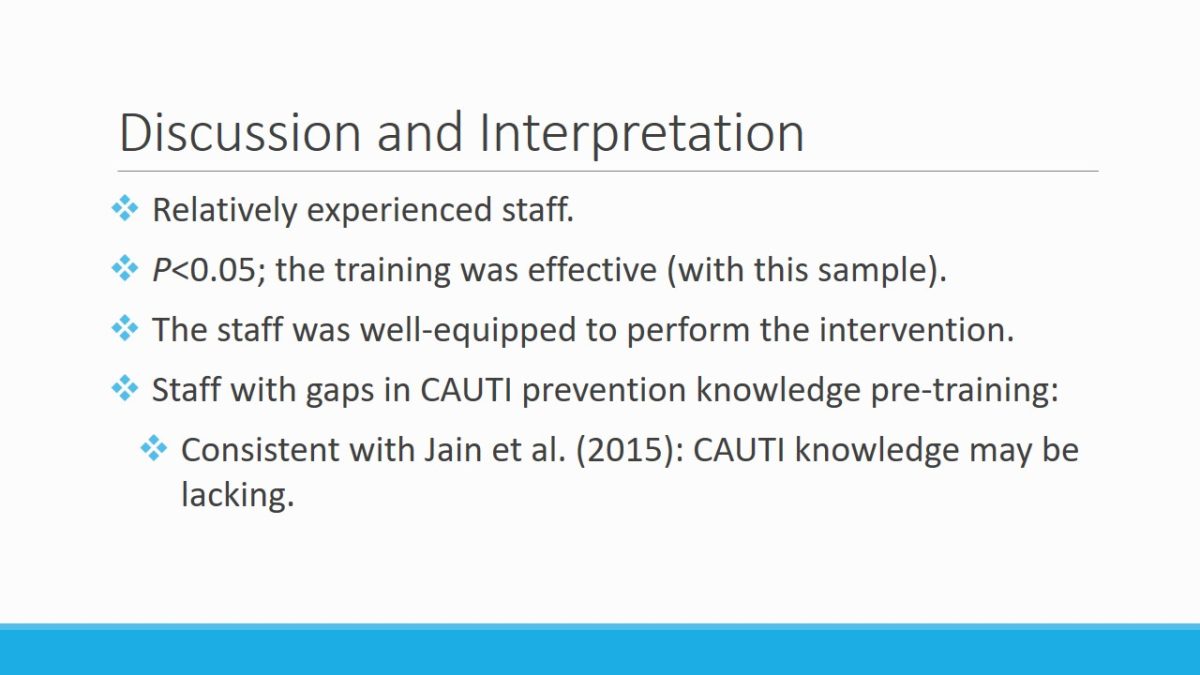
Pre and Post Urinalysis Results (Residents)
Regarding the residents, the final sample consisted of four people. A fifth person was recruited, and his urinalysis was performed, but before the implementation of the washcloths was started, he was transferred, which prevented the project from using his data. As can be seen from the table, 100% of the participants had leukocytes in their urine based on the dipstick analysis, and two of them (50% when the final sample is considered) also had nitrite. None of the residents exhibited any symptoms of CAUTIs, which allowed their enrollment. Their state remained completely unchanged for the duration of the two weeks that they were bathed with the washcloths; their post-test urinalysis results were identical to the pre-test ones.
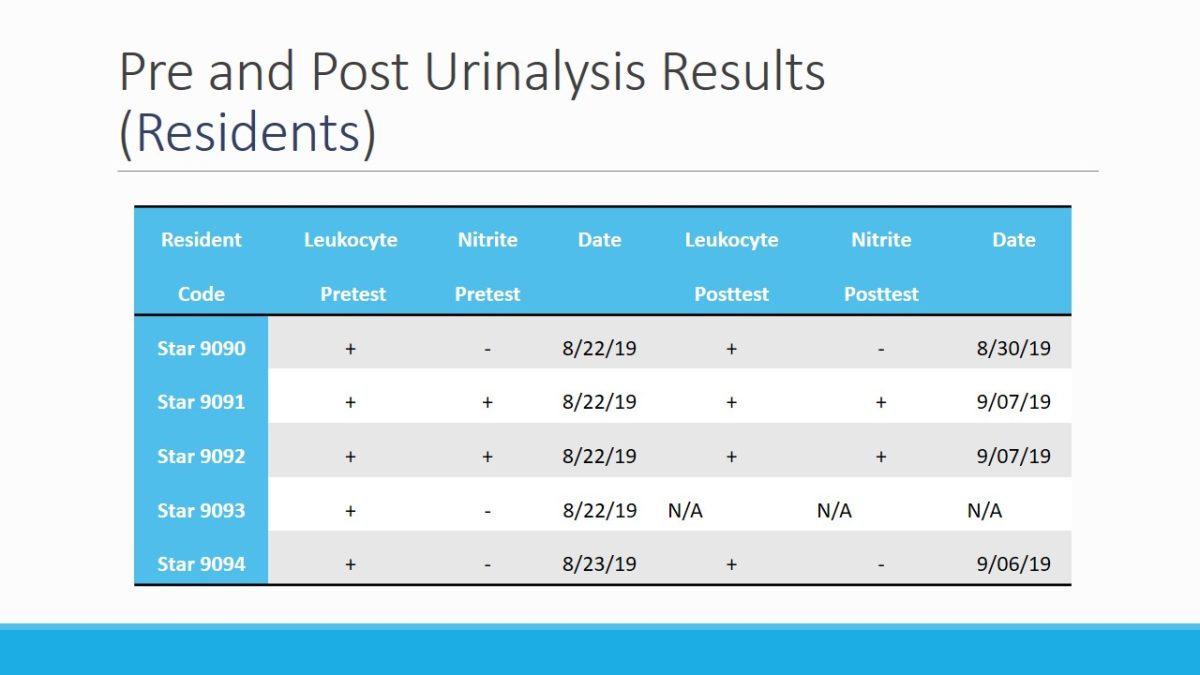
No new CAUTIs: intervention may be effective in preventing CAUTIs (similar to the literature).
But:
- Very small sample (5 pre-intervention; 4 post-intervention).
- Having leukocytes/nitrite in pre-test samples (no CAUTI symptoms).
- Therefore, the evidence is limited.
Based on this information, the washcloths may have prevented the development of CAUTIs and negative changes in the residents’ health. However, with a sample that small and a time period that short, this evidence is not very strong. In addition, while the residents showed no symptoms of CAUTIs, they did have leukocytes in their urine. With few people available at the site, they were deemed eligible for the project, but it is still a limitation to be considered.
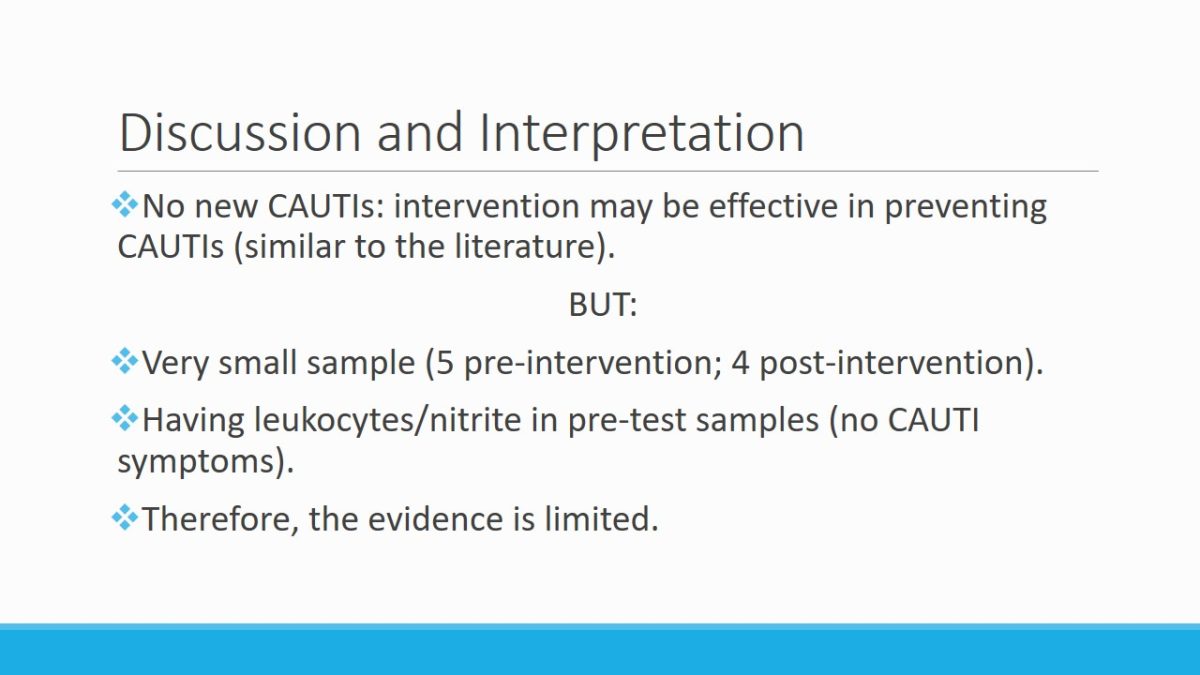
Limitations
- Sample size (both cases; especially residents).
- Sample features.
- Staff: one facility and only nurses; insufficient representation of subgroups (e.g., age, experience; no male nurses).
- Residents: presence of leukocytes/nitrite pre-test.
- Timeframe: 2 weeks of intervention; no follow-ups.
Indeed, the project’s limitations need to be discussed. First, the samples can be considered a limitation; the residents’ sample is especially small, but 26 nursing specialists from one unit do not constitute a large sample either, which limits inferences about nursing populations at large. Similarly, the fact that the nurses’ sample was not very diverse means that the application of findings to different or more specific subgroups should be done very carefully. The residents’ pre-test urinalysis results are a limitation, and so are the short timeframe and the absence of follow-ups. The project cannot make inferences about the long-term effects of the training or intervention.

Implications, Contribution, and Recommendations
- Implications/knowledge contributions:
- There may be CAUTI prevention knowledge gaps.
- Training appears to be effective with nurses.
- Some evidence of the effectiveness of washcloths.
- Future research recommendations:
- greater/more diverse samples and duration;
- consideration of CAUTI knowledge gaps/training.
Some inferences, implications, and recommendations can still be made. First, it is an important finding that even the nurses working in environments where CAUTIs are a major risk might not be sufficiently equipped to address the issue. Therefore, the assessment of the knowledge of nurses and nursing assistants is very important. Second, the project does suggest that training is a suitable solution. Third, the effectiveness of the 2% chlorhexidine washcloth bathing in limiting urinary tract infections in residents with catheters is supported by some evidence, but it is not very strong. As a result, it is recommended to further investigate the intervention and training before making the quality improvement intervention permanent. New research should reflect on and attempt to avoid and prevent the limitations of the current one. Still, the presented project has contributed some information that can be of use to nurses, especially the project’s site and staff, as well as nursing students. From this perspective, the project has been advancing the university’s mission, especially as related to some of the pillars of nursing, including caring and professionalism.
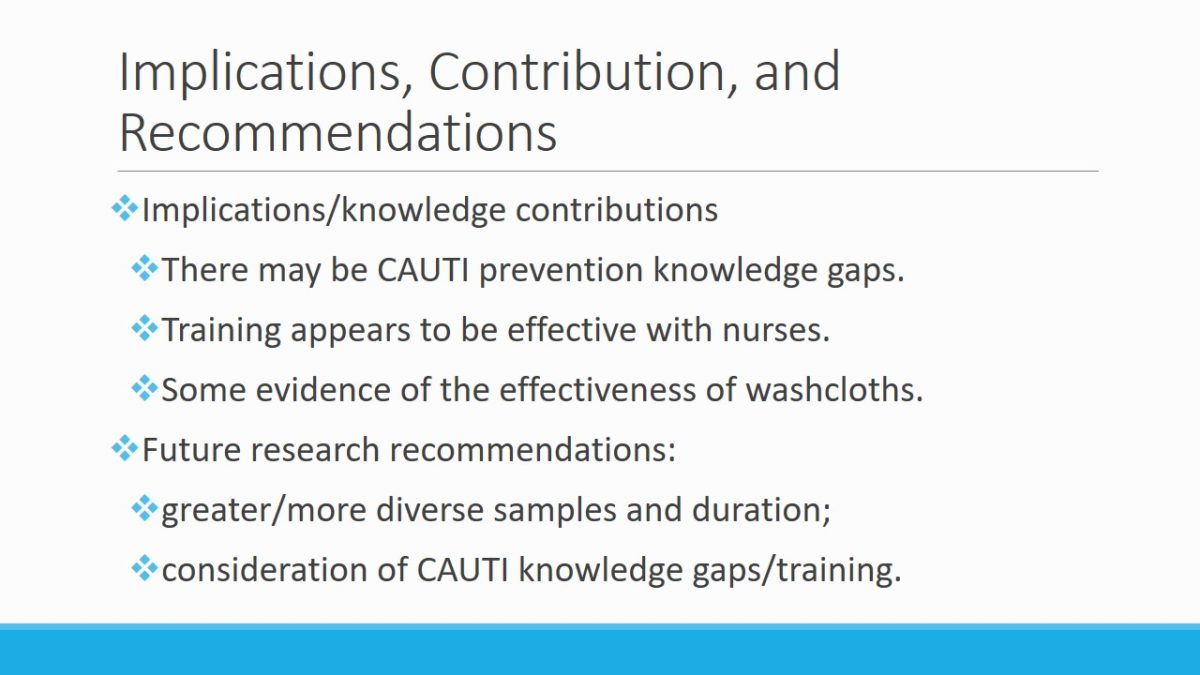
Conclusions
- A pre-test post-test quality improvement project (training + an evidence-based CAUTI prevention intervention).
- Outcomes:
- training was successful (p<0.05);
- no new CAUTIs in residents;
- evidence on CAUTI training and prevention (limited).
- Recommendations: eliminating limitations in future research.
To summarize, the presented project consisted of quality improvement, which incorporated the elements of training and the implementation of an evidence-based intervention. Both activities aimed to reduce CAUTI rates in a unit where they were rather high. The nursing staff was successfully trained, and the residents who were enrolled did not develop CAUTIs. Therefore, the aim was achieved; the project resulted in the staff improving their knowledge and residents remaining without new CAUTIs. The project does contribute some data to CAUTI prevention, but it is not very extensive because of the limited duration and relatively small samples, which is especially relevant and important for the resident sample. Based on the findings, it is a good idea to proceed to explore the intervention and training in long-term settings while attempting to increase the sample size and timeframe of a project.
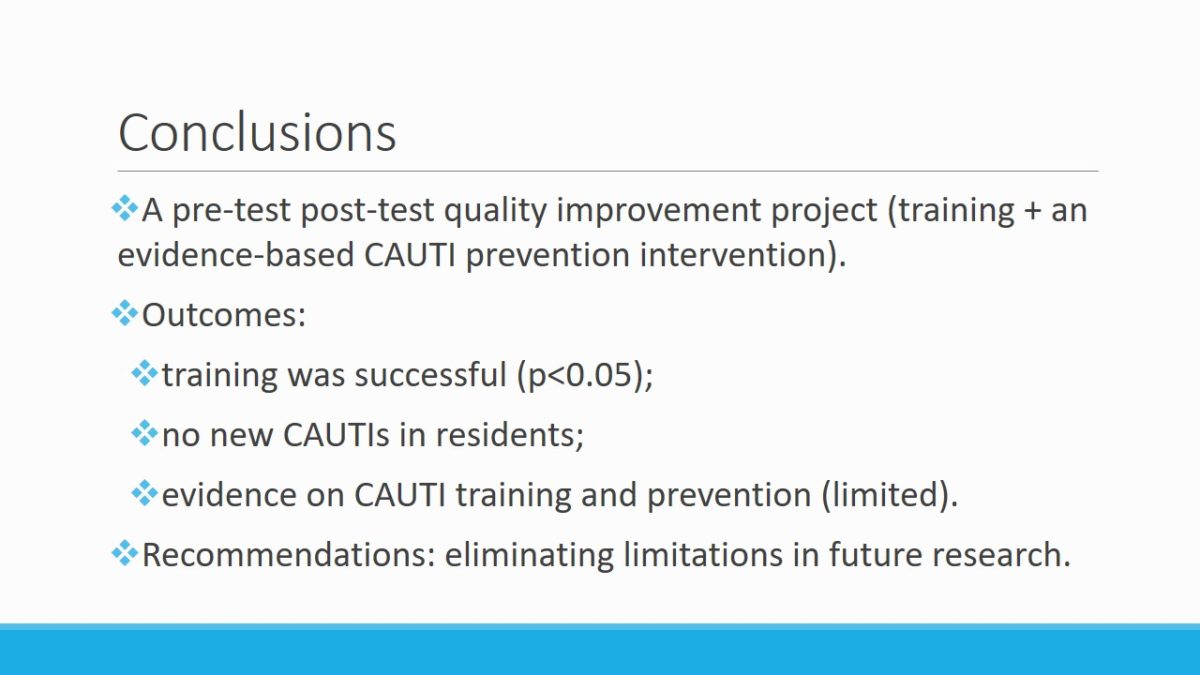
References
Cummings, S., Bridgman, T., & Brown, K. (2016). Unfreezing change as three steps: Rethinking Kurt Lewin’s legacy for change management. Human Relations, 69(1), 33-60. Web.
Huang, H., Chen, B., Wang, H., & He, M. (2016). The efficacy of daily chlorhexidine bathing for preventing healthcare-associated infections in adult intensive care units. The Korean Journal of Internal Medicine, 31(6), 1159-1170. Web.
Jain, M., Thakur, A., Dogra, V., Mishra, B., & Loomba, P. (2015). Knowledge and attitude of doctors and nurses regarding indication for catheterization and prevention of catheter-associated urinary tract infection in a tertiary care hospital. Indian Journal of Critical Care Medicine, 19(2), 76-81. Web.
Nicolle, L. E. (2014). Catheter associated urinary tract infections. Antimicrobial Resistance and Infection Control, 3(23), 1-8. Web.
Jump, R., Crnich, C., Mody, L., Bradley, S., Nicolle, L., & Yoshikawa, T. (2018). Infectious diseases in older adults of long-term care facilities: Update on approach to diagnosis and management. Journal of the American Geriatrics Society, 66(4), 789-803. Web.
Lewin, K. (1947). Group decision and social change. Readings in Social Psychology, 3(1), 197-211.
Mitchell, B. G., Fasugba, O., Cheng, A. C., Gregory, V., Koerner, J., Collignon, P., … Graves, N. (2019). Chlorhexidine versus saline in reducing the risk of catheter associated urinary tract infection: A cost-effectiveness analysis. International Journal of Nursing Studies, 97, 1-6. Web.
Noto, M., & Wheeler, A. (2015). Understanding chlorhexidine decolonization strategies. Intensive Care Medicine, 41(7), 1351-1354. Web.
Polit, D. F., & Beck, C. T. (2017). Nursing research: Generating and assessing evidence for nursing practice (10th ed.). Philadelphia, PA: Lippincott, Williams & Wilkins.
Swan, J. T., Ashton, C. M., Bui, L. N., Pham, V. P., Shirkey, B. A., Blackshear, J. E., … Butler, M. O. (2016). Effect of chlorhexidine bathing every other day on prevention of hospital-acquired infections in the surgical ICU. Critical Care Medicine, 44(10), 1822-1832. Web.